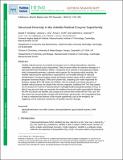| dc.contributor.author | Dowling, Daniel P. | |
| dc.contributor.author | Vey, Jessica L. | |
| dc.contributor.author | Croft, Anna K. | |
| dc.contributor.author | Drennan, Catherine L. | |
| dc.date.accessioned | 2017-05-26T19:00:49Z | |
| dc.date.available | 2017-05-26T19:00:49Z | |
| dc.date.issued | 2012-11 | |
| dc.date.submitted | 2012-04 | |
| dc.identifier.issn | 15709639 | |
| dc.identifier.uri | http://hdl.handle.net/1721.1/109390 | |
| dc.description.abstract | AdoMet radical enzymes are involved in processes such as cofactor biosynthesis, anaerobic metabolism, and natural product biosynthesis. These enzymes utilize the reductive cleavage of S-adenosylmethionine (AdoMet) to afford l-methionine and a transient 5′-deoxyadenosyl radical, which subsequently generates a substrate radical species. By harnessing radical reactivity, the AdoMet radical enzyme superfamily is responsible for an incredible diversity of chemical transformations. Structural analysis reveals that family members adopt a full or partial Triose-phosphate Isomerase Mutase (TIM) barrel protein fold, containing core motifs responsible for binding a catalytic [4Fe–4S] cluster and AdoMet. Here we evaluate over twenty structures of AdoMet radical enzymes and classify them into two categories: ‘traditional’ and ‘ThiC-like’ (named for the structure of 4-amino-5-hydroxymethyl-2-methylpyrimidine phosphate synthase (ThiC)). In light of new structural data, we reexamine the ‘traditional’ structural motifs responsible for binding the [4Fe–4S] cluster and AdoMet, and compare and contrast these motifs with the ThiC case. We also review how structural data combine with biochemical, spectroscopic, and computational data to help us understand key features of this enzyme superfamily, such as the energetics, the triggering, and the molecular mechanisms of AdoMet reductive cleavage. This article is part of a Special Issue entitled: Radical SAM Enzymes and Radical Enzymology. | en_US |
| dc.description.sponsorship | Wellcome Trust (London, England) (091162/Z/10/Z) | en_US |
| dc.description.sponsorship | National Science Foundation (U.S.) (NSF Grant MCB-0543833) | en_US |
| dc.description.sponsorship | Howard Hughes Medical Institute (Investigator) | en_US |
| dc.language.iso | en_US | |
| dc.publisher | Elsevier B.V. | en_US |
| dc.relation.isversionof | http://dx.doi.org/10.1016/j.bbapap.2012.04.006 | en_US |
| dc.rights | Creative Commons Attribution-NonCommercial-NoDerivs License | en_US |
| dc.rights.uri | http://creativecommons.org/licenses/by-nc-nd/4.0/ | en_US |
| dc.source | PMC | en_US |
| dc.title | Structural diversity in the AdoMet radical enzyme superfamily | en_US |
| dc.type | Article | en_US |
| dc.identifier.citation | Dowling, Daniel P., Jessica L. Vey, Anna K. Croft, and Catherine L. Drennan. "Structural diversity in the AdoMet radical enzyme superfamily." Biochimica et Biophysica Acta (BBA) - Proteins and Proteomics Volume 1824, Issue 11, (November 2012), pp. 1178-1195. | en_US |
| dc.contributor.department | Massachusetts Institute of Technology. Department of Biology | en_US |
| dc.contributor.department | Massachusetts Institute of Technology. Department of Chemistry | en_US |
| dc.contributor.mitauthor | Dowling, Daniel P. | |
| dc.contributor.mitauthor | Drennan, Catherine L. | |
| dc.relation.journal | Biochimica et Biophysica Acta (BBA) - Proteins and Proteomics | en_US |
| dc.eprint.version | Author's final manuscript | en_US |
| dc.type.uri | http://purl.org/eprint/type/JournalArticle | en_US |
| eprint.status | http://purl.org/eprint/status/PeerReviewed | en_US |
| dspace.orderedauthors | Dowling, Daniel P.; Vey, Jessica L.; Croft, Anna K.; Drennan, Catherine L. | en_US |
| dspace.embargo.terms | N | en_US |
| dc.identifier.orcid | https://orcid.org/0000-0001-5486-2755 | |
| dspace.mitauthor.error | true | |
| mit.license | PUBLISHER_CC | en_US |
